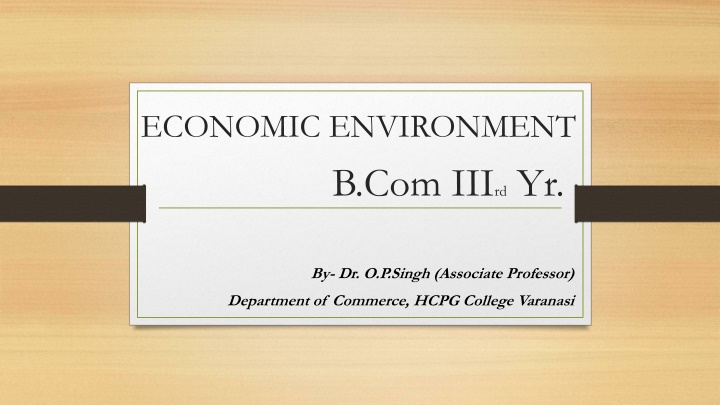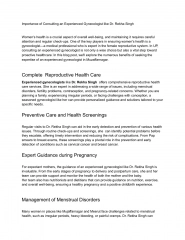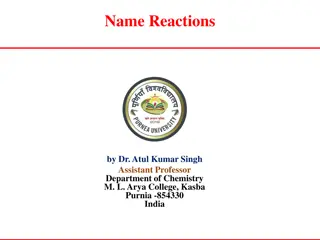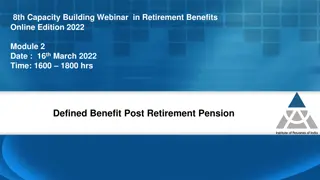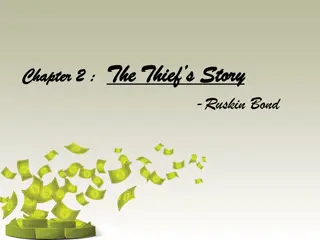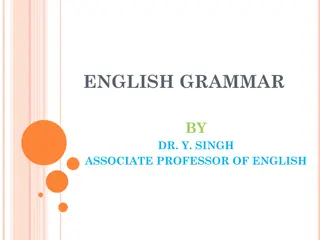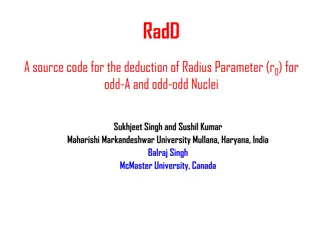Economic Environment in B.Com IIIrd Yr by Dr. O.P. Singh
This course delves into the Indian economic environment, covering concepts, components, and importance. Explore economic trends and problems of growth, along with the role of the government and the international economic landscape. Understand the dynamic factors influencing economic activities and the significance of various elements in the economic environment.
Download Presentation

Please find below an Image/Link to download the presentation.
The content on the website is provided AS IS for your information and personal use only. It may not be sold, licensed, or shared on other websites without obtaining consent from the author.If you encounter any issues during the download, it is possible that the publisher has removed the file from their server.
You are allowed to download the files provided on this website for personal or commercial use, subject to the condition that they are used lawfully. All files are the property of their respective owners.
The content on the website is provided AS IS for your information and personal use only. It may not be sold, licensed, or shared on other websites without obtaining consent from the author.
E N D
Presentation Transcript
ECONOMIC ENVIRONMENT B.Com IIIrd Yr. By- Dr. O.P.Singh (Associate Professor) Department of Commerce, HCPG College Varanasi
Syllabus Unit-I Indian Economic Environment: Concept, Components and Importance Economic Trends (overview): Income; Savings and Investments, Industry; Trade and Balance of Payments, Money; Finance; Prices. Unit-II Problems of Growth: Unemployment; Poverty, Regional Imbalances, Social Injustice; Inflation; Parallel economy; Industrial sickness. The Current Five Years plan: Major policies; Resources allocation. Unit-III Role of Government: Monetary and Fiscal Policy; Industrial policy; Industrial licensing. Privatization; Devaluation; Export-Import Collaboration in the light of Recent Changes. Unit-IV International Environment: International Trading Environment (overview): Trends in the World Trade and The problems of Developing Countries; Foreign Trade and Economic Growth; International Economic Groupings; International Economic Institutions. GATT, WTO, UNCTAD World Bank, IMF, GSP, GSTP; Counter Trade. Policy; Regulation of Foreign Investment;
UNIT-1 Economic Environment- An Introduction Economic Environment is made up to two words: --- Economic + Environment Economic activity In ordinary sense, a person to satisfy his wants is called economic activity. Economic is all about in economy, about its limited or scarce resources and limited human wants environment we have already defied it above. Economic conditions economic policies and the economic system are important external factors that constitute economic environment. E-E The economic conditions of a country for example. The nature of the economy the stage of development of the economy, economic resources the level of Y its distribution etc.
Objectives of Economic Environment. Following are the main objectives of economic environment study:-- Power functioning of an economy Knowledge of new opportunities and resources Study of environmental factors Removal of obstacles and challenges Optimum use of environment Minimizing ill effects.
Components Of Economic Environment At present economic environment is a complex phenomenon. It deals with government policies optical, manly marketing, household sector and foreign sector. Transport & Communication International Conditions Social & Culture Conditions Constitutional Conditions Political Conditions Population Conditions Natural Resources Economic laws Capital market
Importance Of Economic Environment Dynamic Effect of Various Factors Related with Economic Activities Infrastructure Role of Govt. Economic Disparities. Public Morality.
Economic Polices Eco Policy is the government policy through which economic activities of a country are regulated. Policies are made in order to maintain full employment, maintain high rate of economic growth increase eco welfare, maintaining stability of money.
Objectives of Economic Policy (1) Employment opportunities (2) Rapid Eco Development (3) Economic stability (4) Max social welfare (5) Eco Equality & Justice (6) Eco Liberty (7) Increase in Production (8) Encouragement to Planned Development (9) To Increase Exports (10) Co-ordination b/w private & public sector.
Balance of Trade The balance of trade is the difference between the monetary value of exports and imports of output in an economy over a certain period. It is the relationship between a nation s imports and exports. A positive balance is known as a trade surplus if it consists of exporting more than is imported; a negative balance is referred to as a trade deficit or, informally, a trade gap. The balance of trade is sometimes divided into a goods and a services balance.
Balance of Payments The Balance of Payments or BoP is a statement or record of all Monetary and economic transactions made between a country and the rest of the world within a defined period (every quarter or year). These records include transactions made by individuals, Companies and the Government. Keeping a record of transactions helps the country to monitor the flow of money and develop policies that would help in building a strong economy. The BoP consists of three main components current account, capital account, and Financial account. As mentioned earlier, the BoP should be zero. The current account must balance with the combined capital and financial accounts. these
Monetary Policy Monetary policy is a policy statement, through which the Reserve Bank of India targets a KEY-SET of indicators to ensure price stability. These KEY-SET of indicators are: a. Money supply b. Interest rates, and c. Inflation
Globalisation Globalization can be simply defined as the expansion of economic activities across political boundaries of the native state. In wider sense, it is a process of deepening economic integration, increasing economic openness and growing economic interdependence between the countries of the world economy. Reduction of trade barriers, so as to permit free flow of goods and services across national frontiers. Creation of an environment in which free flow of capital can take place among nations. Creation of environment permitting free flow of technology and Creation of an environment in which free movement of labour can take place in different countries in the world.
Industry: An Introduction Industries are part of the secondary activity. Secondary activities or manufacturing converts raw material into products of more value to people. Industry refers to economic activities concerned with the production of goods, extraction of services and provision or services. Hence we can say that Industries are concerned with: Production of good (steel energy) Extraction of minerals (coal mining) Provision for services (tourism) There are also Emerging Industries: Sunrise Industries
Classification of Industry Primary Industry It is one which uses natural resources as their raw materials. These industries depend upon nature for caring out of their activities. These take out the raw materials from the earth s surface. They are found in areas where these natural resources are easily found. Breeding and Reproduction of species come under the primary industry. These industries require little effort and don t require any processing stage. These are divided into two Extractive industry & Genetic industry. The extractive industry is one which acquires natural resources. The genetic industry is one which aims at the breeding of species. Secondary Industry These industries depend on the primary industry for their activities. They use the goods produces by the primary industry as their raw material. These industries create form utility by producing consumer-ready products. It involves the conversion of raw material into finished good using manpower and machines. Secondary industries are of 2 types: Manufacturing and assembling industry.
Tertiary Industry These industries are termed as aids to trade as they help in trade. This industry provides service facilities to other industries. Primary & secondary industry depends on these industries for their role. They do not produce any goods like primary and secondary industry. Examples of tertiary industry: transport, insurance & banking industry.
BUDGET In the general sense, the budget is described as a precise statement, representing a financial estimate of income and expenditure of the government for a certain period. In cost accounting, budget means a quantitative statement, prepared before a particular period to serve as an estimate of future receipts and disbursements. It is an estimate of the economic activities of an entity which related to a specified future period. It must be written and approved by the appropriate authority. It should be modified or corrected, whenever, there is a change in circumstances. It plays the role of a business barometer that helps in measuring the performance of the business by comparing actual and budgeted results.
